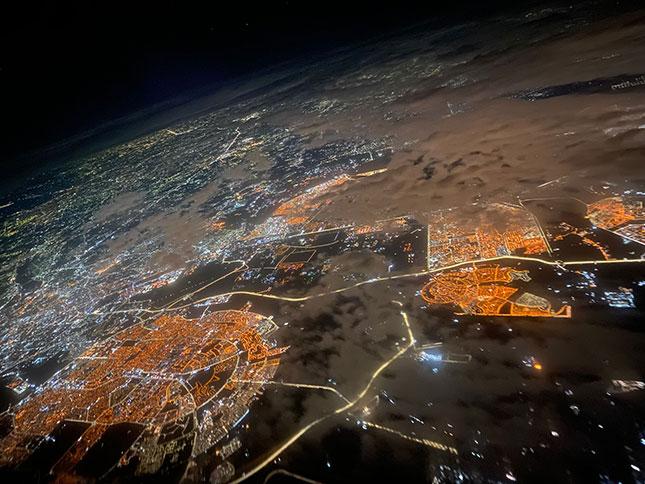Mark Vanhoenacker is an airline pilot and author of Skyfaring: A Journey With a Pilot and the forthcoming Imagine a City: A Pilot’s Journey Across the Urban World (Knopf, July 5, 2022). He spoke with City Journal associate editor Daniel Kennelly.
How many cities have you flown to over the course of your career as a commercial airline pilot?
Finally, a reason to check your email.
Sign up for our free newsletter today.
I began my research for Imagine a City by asking myself that same question. I found a 2018 United Nations report that listed the world’s 548 largest cities, and I calculated that I’d been to around a quarter of them, either as a pilot or as an ordinary traveler.
However, pilots’ unique experience of cities isn’t defined only by the number of cities we visit but also by the frequency with which we visit each one. My logbook—an Excel spreadsheet these days, rather than the blue, finely lined, leather-bound book I began my career with—records that I’ve flown from London to cities such as Beijing, Istanbul, and Lisbon more than a dozen times each; to Vancouver, Cape Town, Tokyo, and Boston more than two dozen times; and to New York, San Francisco, and Los Angeles more than 50 times. For a long time, Seoul was the largest city I had not been to as a pilot; now it’s Jakarta.
You write that being a pilot has given you at least two ways of looking at cities—seeing them from the pilot’s seat far above, and then during your brief, albeit frequent, stays in them. Could you tell us about the changes you’ve seen in cities over the course of your career—first, from the bird’s eye view?
When I began flying long-haul routes, I was struck by the near-emptiness of so much of the world. Large parts of Canada, Russia, and Saharan Africa, for example, from above and at night, remain almost entirely dark. The contrast with the brightness of the city we departed from, or the one we’re flying toward, is striking.
Urbanization seems to be a defining feature of our civilization, and I like to think that I’ve had glimpses of this process from above—however uneven and imprecise such visual impressions must be—especially as I move over regions of the world that were once unfamiliar to me.

And what changes have you witnessed from your many short-term stays?
In Imagine a City, I mention that after I got a phone that tracked my steps, I realized that my highest-ever step counts were my first days in new cities—a pleasing fact that suggests how these visits may represent some of the most memorable days of my life.
Despite this, however, the most practical change for me has been the spread of rapid transit in cities that I may previously have found hard to navigate. Delhi plays a prominent role in my new book, in part because its metro has transformed my experience of a city likely to become the world’s largest. A new or fast-growing metro in as vast a city as Delhi reminds me of what a miracle it is to be able to choose a place to explore—a café, a monument, a characterful or globalization-resistant shopping street—and to travel quickly to it, with no more knowledge of the metropolis than that provided by the neat lines on a network map.
As a pilot, what tricks have you learned for getting around in a new city on a new route?
You won’t be surprised to learn how much the aerial perspective means to me as a pilot who’s also a fan of skyscrapers (let alone as someone who, as a kid, liked to draw maps of both real and imagined cities). My first destination in a metropolis that’s new to me is almost always a point high enough to allow me to get my bearings—Kondiaronk Belvedere in Montreal, the TV Tower in Sapporo, Galata Tower in Istanbul—followed by coffee and the first of many long walks.

Your hometown—Pittsfield, Massachusetts—plays a major role in the book. Can you tell us about its importance in your recollections?
William Carlos Williams—I found Paterson so inspiring—found the universal in the local. The nature of a pilot’s job requires that we approach similar truths but from the opposite direction. As I walk through yet another city far from where I was born and grew up, I’m often struck by the realization that my thoughts have returned to Pittsfield, and to times and places there that may be only loosely analogous to whatever I’m perceiving in an unfamiliar place. It’s as if the kid who once loved to spin the light-up globe in his bedroom as he dreamed of foreign places grew into an adult who now can’t help but spin it back to his hometown.
What’s your favorite book about cities in general, or about one city in particular?
I suppose I can’t nominate Herman Melville’s Moby-Dick as a city book, though it was written in Pittsfield (and its opening pages transport us from the “insular city of the Manhattoes” to New Bedford, whose lovely epithet—“The City that Lit the World”—may even outrank that of Paris), so I’ll go with Italo Calvino’s Invisible Cities. Aside from its dream-like language, I love how it plays with the suggestion that the many disparate cities it describes are, in fact, one—and that therefore the lives of cities may unfold first, or perhaps even primarily, in our imaginations.
